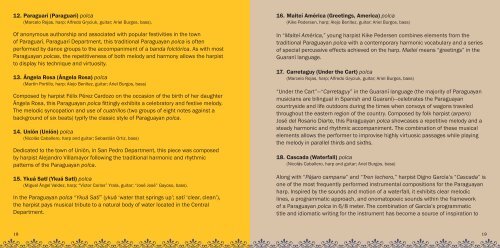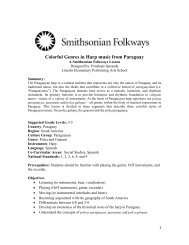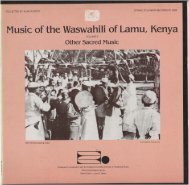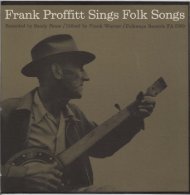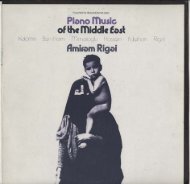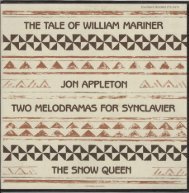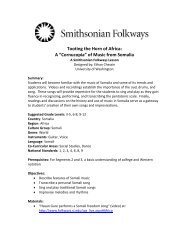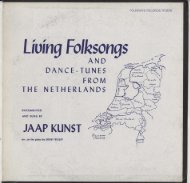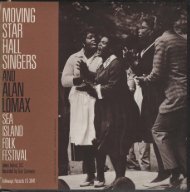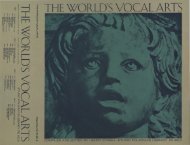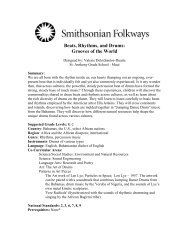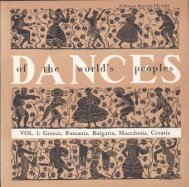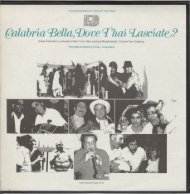Maiteí América: Harps of Paraguay
Maiteí América: Harps of Paraguay
Maiteí América: Harps of Paraguay
You also want an ePaper? Increase the reach of your titles
YUMPU automatically turns print PDFs into web optimized ePapers that Google loves.
12. Paraguarí (Paraguarí) polca<br />
(Marcelo Rojas, harp; Alfredo Gryciuk, guitar; Ariel Burgos, bass).<br />
Of anonymous authorship and associated with popular festivities in the town<br />
<strong>of</strong> Paraguarí, Paraguarí Department, this traditional <strong>Paraguay</strong>an polca is <strong>of</strong>ten<br />
performed by dance groups to the accompaniment <strong>of</strong> a banda folclórica. As with most<br />
<strong>Paraguay</strong>an polcas, the repetitiveness <strong>of</strong> both melody and harmony allows the harpist<br />
to display his technique and virtuosity.<br />
13. Ángela Rosa (Ángela Rosa) polca<br />
(Martín Portillo, harp; Alejo Benítez, guitar; Ariel Burgos, bass)<br />
Composed by harpist Félix Pérez Cardozo on the occasion <strong>of</strong> the birth <strong>of</strong> her daughter<br />
Ángela Rosa, this <strong>Paraguay</strong>an polca fittingly exhibits a celebratory and festive melody.<br />
The melodic syncopation and use <strong>of</strong> cuatrillos (two groups <strong>of</strong> eight notes against a<br />
background <strong>of</strong> six beats) typify the classic style <strong>of</strong> <strong>Paraguay</strong>an polca.<br />
14. Unión (Unión) polca<br />
(Nicolás Caballero, harp and guitar; Sebastián Ortiz, bass)<br />
Dedicated to the town <strong>of</strong> Unión, in San Pedro Department, this piece was composed<br />
by harpist Alejandro Villamayor following the traditional harmonic and rhythmic<br />
patterns <strong>of</strong> the <strong>Paraguay</strong>an polca.<br />
15. Ykuá Sati (Ykuá Sati) polca<br />
(Miguel Ángel Valdez, harp; “Víctor Carlos” Yrala, guitar; “José José” Gayoso, bass).<br />
In the <strong>Paraguay</strong>an polca “Ykuá Sati” (ykuá ‘water that springs up’; sati ‘clear, clean’),<br />
the harpist pays musical tribute to a natural body <strong>of</strong> water located in the Central<br />
Department.<br />
16. <strong>Maiteí</strong> <strong>América</strong> (Greetings, America) polca<br />
(Kike Pedersen, harp; Alejo Benítez, guitar; Ariel Burgos, bass)<br />
In “<strong>Maiteí</strong> <strong>América</strong>,” young harpist Kike Pedersen combines elements from the<br />
traditional <strong>Paraguay</strong>an polca with a contemporary harmonic vocabulary and a series<br />
<strong>of</strong> special percussive effects achieved on the harp. <strong>Maiteí</strong> means “greetings” in the<br />
Guaraní language.<br />
17. Carretaguy (Under the Cart) polca<br />
(Marcelo Rojas, harp; Alfredo Gryciuk, guitar; Ariel Burgos, bass)<br />
“Under the Cart”—“Carretaguy” in the Guaraní language (the majority <strong>of</strong> <strong>Paraguay</strong>an<br />
musicians are bilingual in Spanish and Guaraní)—celebrates the <strong>Paraguay</strong>an<br />
countryside and life outdoors during the times when convoys <strong>of</strong> wagons traveled<br />
throughout the eastern region <strong>of</strong> the country. Composed by folk harpist (arpero)<br />
José del Rosario Diarte, this <strong>Paraguay</strong>an polca showcases a repetitive melody and a<br />
steady harmonic and rhythmic accompaniment. The combination <strong>of</strong> these musical<br />
elements allows the performer to improvise highly virtuosic passages while playing<br />
the melody in parallel thirds and sixths.<br />
18. Cascada (Waterfall) polca<br />
(Nicolás Caballero, harp and guitar; Ariel Burgos, bass)<br />
Along with “Pájaro campana” and “Tren lechero,” harpist Digno García’s “Cascada” is<br />
one <strong>of</strong> the most frequently performed instrumental compositions for the <strong>Paraguay</strong>an<br />
harp. Inspired by the sounds and motion <strong>of</strong> a waterfall, it exhibits clear melodic<br />
lines, a programmatic approach, and onomatopoeic sounds within the framework<br />
<strong>of</strong> a <strong>Paraguay</strong>an polca in 6/8 meter. The combination <strong>of</strong> García’s programmatic<br />
title and idiomatic writing for the instrument has become a source <strong>of</strong> inspiration to<br />
18 19


